Kittens, with their boundless energy and endless curiosity, can sometimes seem like tiny whirlwinds of chaos. Their playful antics, while adorable, may leave many owners wondering: when do kittens calm down? In this guide, we’ll explore the factors that influence a kitten’s energy levels, and discuss when you might expect your feline friend to transition into a more sedate adulthood.
At What Age Do Kittens Calm Down?
Typically, kittens start to calm down or “mellow out” around the age of one year. However, this is not a hard and fast rule as it may slightly vary depending on the breed and individual personality of the cat.
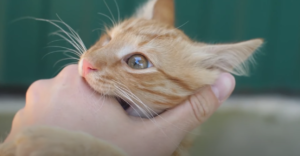
Birth To 1 Year Old
During the first year of their life, kittens go through a phase of rapid growth and development. This period marks their most active and playful stage, full of exploration, mischief, and games. During the first few months, their energy levels will likely peak, as they are learning about their environment and developing their hunting skills. Around the age of six months, you may start to notice a slight decrease in their energy levels as they start maturing. However, don’t expect your kitten to transform overnight into a calm adult cat. The transition is gradual, and each kitten is unique, with some remaining playful well beyond their first year.
After Year 1
Once kittens pass the one-year mark, they generally start to settle down. Their growth rate slows, and they begin to display less hyperactive behavior. However, this does not mean they lose their playful nature altogether. Many cats continue to have playful bouts and curious explorations, though these episodes may be less frequent and less intense. Individual behavior can vary significantly, with some cats retaining their kitten-like energy well into their second year and beyond. It’s important to note that regular exercise and mental stimulation can also affect a cat’s activity level. So, owners should continue to engage their cats in play and provide them with stimulating toys and environments to support their overall wellbeing. [1]
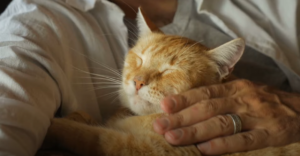
Senior Years
As cats reach their senior years, typically around 7 years old, you’ll likely notice a significant decrease in their activity levels. The energetic play sessions may give way to longer periods of rest. That said, it’s essential not to mistake this change in behavior for laziness or disinterest. Senior cats, like their younger counterparts, benefit from regular mental and physical stimulation—albeit at a more gentle pace. Interactive toys, puzzle feeders, or gentle play sessions can help keep your senior cat’s mind sharp and body agile. However, it’s equally crucial to monitor your senior cat closely for any drastic or sudden changes in behavior, as this could signal health issues. Always consult with a vet if you have any concerns about your cat’s activity levels or overall wellbeing.
Reasons For Hyperactivity Beyond Age
Several factors beyond age can contribute to a cat’s hyperactivity.
Breed: Certain breeds are known for their energetic nature. Breeds like the Bengal, Siamese or Maine Coon, for instance, are typically more active and playful than others, and this trait can extend into adulthood.
Diet: A cat’s diet can also affect its energy levels. Feeding your cat a balanced, nutritious diet can ensure it has the required energy for growth and play. Conversely, a diet high in sugar or carbohydrates could lead to spikes in energy levels, leading to hyperactive behavior.
Lack of Stimulation: Cats can often appear hyperactive if they’re bored or lack stimulation. Providing a variety of toys, puzzles, and play opportunities can help channel this energy constructively.
Health Issues: In some cases, hyperactivity may be a symptom of underlying health issues, such as hyperthyroidism or certain neurological conditions. If your cat’s hyperactivity is accompanied by other symptoms, or if you’re concerned about their behavior, it’s recommended to consult with a vet.
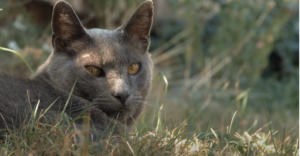
Remember, every cat is unique. Some may naturally have higher energy levels than others, regardless of their age or breed. What’s most important is that your cat is healthy, happy, and engaged in its environment. [2]
Management Techniques
Managing a kitten’s high energy levels can sometimes be a challenging task. However, there are several techniques you can use to help your kitten burn off energy while also keeping them engaged and happy.
Create Hunt-Like Situations
Creating hunt-like situations for your cat is an effective way to manage their energy levels. Engaging in these activities will stimulate your cat’s natural predator instincts and provide them with the physical and mental exercise they require. Use toys that mimic the movement and behavior of prey, such as mice or birds. Wand toys, laser pointers, and motorized toys can be particularly effective in this regard. Implementing interactive play sessions daily for about 10 to 15 minutes can significantly help burn off your cat’s excess energy and bring about a sense of calm and satisfaction. Always remember to let your cat catch and “kill” the toy from time to time to fulfill their hunting instinct and prevent frustration. Furthermore, puzzle feeders that require some effort to obtain food can simulate the challenge of hunting, keeping your cat occupied and mentally stimulated.
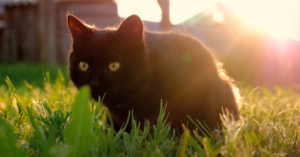
Give Them Their Own Toys
Providing your cat with their own toys is another effective strategy to manage their energy levels. Toys offer an outlet for your cat’s natural instinct to hunt and play. They cater to their curiosity, help burn off energy, and can even help reduce potential destructive behavior by keeping them entertained.
Rotate the toys regularly to maintain your cat’s interest, but always ensure that a few favorites are always available. Some cats also enjoy puzzle toys that dispense treats, as they provide both physical and mental stimulation. Supervised play sessions using these toys can be a bonding experience for both you and your cat, strengthening your relationship while keeping your feline friend active and happy.
Don’t Just Use Your Body
While physical interaction with your cat can be enjoyable and beneficial for bonding, it’s not advisable to use your hands, feet, or any part of your body as playthings. Encouraging your cat to bite or scratch your body during play can lead to inappropriate play behavior, which can result in accidental injury. Instead, use toys to interact with your cat, keeping a safe distance between your cat’s claws and your skin. Teaser toys, laser pointers, or remote-controlled toys are excellent for this purpose, as they can engage your cat in a fun, stimulating game while keeping your hands out of reach. This way, your cat learns appropriate play behavior, and playtime remains a safe and enjoyable activity for both of you. [3]
Tips For Calming A Hyperactive Cat
Regular Playtime: Establish a consistent playtime schedule for your cat to expend their energy constructively. This could be a couple of short 15-minute sessions scattered throughout the day, or a longer session in the evening before sleep time. The key here is consistency, as cats thrive on routine.
Create a Calming Environment: Provide a calming environment for your cat with the help of soothing music or white noise machines. Soft classical music or sounds of nature can help relax an overly hyper cat.
Catnip Toys: Catnip, a plant that most cats are irresistibly drawn to, can be a useful tool. Toys stuffed with catnip can provide a source of entertainment for hyperactive cats. After a period of energetic play, most cats will have a period of relaxation and sleep.
Feliway Diffusers: Feliway diffusers mimic the feline facial pheromone that cats use to mark their territory as safe and secure. Using these in your home can help create a calming environment and reduce hyperactive behavior in cats.
Professional Consultation: If you find that none of the above tips work and your cat’s hyperactivity continues to be an issue, it may be worth consulting with a vet or a professional cat behaviorist. They can provide more personalized advice based on your cat’s specific needs and behavior.

Remember, patience is key when managing a hyperactive cat. It may take some time to find what works best for your feline friend, but the results will be worth the effort as you enjoy a happier, calmer cat and a more peaceful household. [4]
Surroundings To Enrich Your Kitten
Ensuring your kitten has a rich and stimulating environment is crucial for their development and overall well-being. There are several ways to enrich your cat’s surroundings:
Climbing Spaces: Cats are natural climbers. Providing vertical spaces such as cat trees, shelves, or window perches can allow them to survey their surroundings from a safe vantage point. These climbing spaces also provide a form of exercise and can be especially helpful in managing the energy levels of a hyperactive kitten.
Variety of Textures: Cats are sensory creatures. Having a variety of textures in their environment, such as soft bedding, scratch posts, and different types of toys, can keep them engaged and stimulated.
Safe Outdoor Access: If possible, providing safe and controlled outdoor access can greatly enrich your cat’s environment. This could be in the form of a secure garden, a catio, or supervised time on a leash. The sights, sounds, and smells of the outdoors provide a level of stimulation that is hard to replicate indoors.
Quiet Zones: While play and exploration are important, kittens also need quiet, safe spaces to retreat to for rest. This could be a cozy bed in a quiet corner, or a covered hideaway.
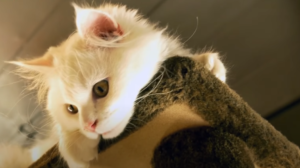
Remember, the key to enriching your kitten’s surroundings is balance. A mix of play areas, quiet spaces, and sensory experiences will help ensure your kitten grows up to be a happy, well-adjusted cat. [5]
FAQ
What age do kittens get easier?
Kittens typically start to calm down around 8 to 12 months of age as they transition into their adult phase. However, this can vary depending on factors such as breed, individual personality, and environment. During this period, your kitten’s high-energy play sessions may decrease in frequency and intensity, but it’s important to maintain a routine of regular play and stimulation to cater to their ongoing instinctual needs. It’s also worth noting that even as they mature, cats remain playful and curious, which are traits that contribute to their charm and appeal.
What age are kittens the naughtiest?
Kittens are usually the naughtiest between the ages of 3 to 6 months. This is a crucial period in their development where they explore their surroundings, learn social skills, and develop hunting instincts. Hence, they may engage in “naughty” behaviors like pouncing, climbing, and scratching as they play and learn. However, it’s important to remember that what may seem like mischief is an essential part of their growth and development. Providing appropriate toys, teaching them boundaries, and ensuring they have plenty of playtime can help manage their energy levels and reduce potentially destructive behavior.
How do you calm a hyper kitten?
To calm a hyper kitten, follow these strategies:
- Interactive Playtime: Play with your kitten regularly using toys that simulate prey, like toys on strings or laser pointers. This helps drain their energy and satisfies their hunting instincts, which can lead to them being calmer after playtime.
- Adequate Feeding: Kittens are growing and thus have high energy needs. Ensure you’re feeding them a nutritious and balanced diet to meet their energy requirements, which can help manage their hyperactivity.
- Create a Calm Environment: A calm and quiet environment can help relax a hyper kitten. Minimize loud noises and sudden movements that might excite or scare them.
- Consistent Routine: Kittens thrive on routine. Consistency in feeding, playing, and bedtime can help create a sense of security and reduce hyperactivity.
- Safe Space: Provide your kitten with a safe and quiet space where they can retreat when tired or overwhelmed.
- Socialization: Allow your kitten to interact with other friendly and vaccinated pets. This can aid in draining their energy and teaching them social cues from older pets.
Remember, every kitten is different and what works for one might not work for another. If your kitten’s hyperactivity seems excessive or you’re struggling to calm them down, it’s always a good idea to consult with a vet or a professional cat behaviorist.
What is the hardest kitten age?
The most challenging age for kittens is usually between 2 to 4 months of age. This is often referred to as the “kitten chaos” stage. During this time, kittens are growing rapidly and are extremely curious, leading to exploratory behavior as they learn about their environment. This can often manifest as mischief, with kittens climbing on furniture, pouncing on unseen enemies, and even occasionally getting into areas they shouldn’t. This stage requires a great deal of patience and supervision from owners, as well as providing ample safe outlets for their energy and curiosity. However, as the kittens mature and their owners respond consistently to their behaviors, they will gradually become less unruly and easier to manage. So, don’t be discouraged if your kitten seems to be causing chaos – it’s all part of their natural development and with proper care and attention, they will grow into well-behaved adult cats.
Will my kitten always be hyper?
While it might seem like your kitten’s hyperactivity has no end in sight, rest assured, it’s a normal part of their growth and development. Kittens, much like human children, have a lot of energy that they need to burn off, which is essential for their physical development, learning, and socialization. As they grow older, especially after being spayed or neutered, kittens tend to calm down. By the time they reach one to two years of age, most cats are noticeably less active. However, every cat is unique, and some may retain their playful and active nature into their adult years. It’s crucial to continue providing physical and mental stimulation throughout their life to promote overall well-being. Bear in mind that sudden changes in activity levels, either increased or decreased, should warrant a veterinary consultation, as it may indicate health issues. So, while your kitten may not always be hyper, they will always have playful and curious spirits that make them wonderful companions.
Are 2 kittens easier than 1?
Adopting two kittens instead of one can actually be advantageous in many ways. Kittens often benefit from having a companion of the same age group to interact with. They can play and learn together, which can help in their social development. Having a playmate can also prevent them from getting bored, which may reduce the chances of destructive behavior. Simultaneously, two kittens can comfort each other, particularly in new or stressful situations. However, it’s worth noting that two kittens mean double the responsibility, including feeding, cleaning, health checks, and potential veterinary costs. Prospective owners should thoroughly consider these factors before deciding on the number of kittens to adopt. So, while it may not necessarily be “easier,” adopting two kittens can bring more joy and companionship to both the cats and their owners.
What is the single kitten syndrome?
“Single Kitten Syndrome” is a term used to describe a range of behavioral issues that can arise when a kitten is raised without the company of its siblings or other kittens of a similar age. Without a playmate to interact with, single kittens may not develop proper social skills, including communication signals and the acceptable boundaries of play, which are typically learned through play-fighting and other interactions with their peers. They can also become overly reliant on their human caregivers for social interaction and may exhibit increased levels of hyperactivity, aggression, or other problematic behaviors due to lack of mental and physical stimulation. However, this does not mean that a single kitten cannot grow into a well-adjusted adult cat. It just underscores the importance of providing adequate socialization and interactive play opportunities to single kittens, especially during the crucial early stages of their development.
At what age does a kittens personality change?
A kitten’s personality begins to change and mature as they transition into adulthood, typically around one year of age. However, significant development and behavioral changes may start to appear as early as six months, when kittens reach adolescence. This is a critical period for social and behavioral development, and it’s when kittens begin to exhibit more adult-like behaviors. Despite these changes, a cat’s basic personality traits – like being playful, shy, aggressive, or friendly – often remain constant from kittenhood to adulthood. It’s also important to note that a cat’s behavior and temperament can still be influenced by their environment and experiences throughout their life. Therefore, consistent socialization, training, and positive experiences are key to shaping a well-adjusted, sociable adult cat. So, while a kitten’s personality may change as they grow, their core traits will remain the same, and with proper care and attention, they can develop into wonderful companions.
At what age do kittens like to be pet?
Kittens generally start to enjoy being petted once they have been properly socialized, which usually begins around 2 to 7 weeks of age. The key is to handle them gently and frequently during this period to help them get used to human touch. By 8 to 10 weeks, most kittens are comfortable being petted. However, each kitten is different, and their individual personalities and experiences can greatly influence their comfort level with being petted. Some might take longer to enjoy it, while others may enjoy it from a very young age. Regardless, it’s important to approach a kitten slowly, pet them in a direction consistent with their fur, and avoid touching sensitive areas like the belly, until they’re completely comfortable with you. Always observe their reactions and stop if they show signs of discomfort.
Do kittens grow out of biting?
Yes, kittens generally grow out of the biting phase as they mature and learn appropriate behavior. Kittens primarily use their mouths to explore their environment, and biting is a natural part of their play and social interaction. This behavior is often more prevalent in kittens who were not socialized with their siblings, as they miss out on the important lessons of bite inhibition learned through play-fighting. However, consistent training and positive reinforcement can help curb this behavior. It’s essential to redirect their biting to appropriate outlets, such as toys, and to withdraw attention when they bite humans. This helps them learn that biting people is not acceptable. Over time, with maturity and consistent guidance, most kittens will outgrow this phase. However, if aggressive biting continues into adulthood, it could signify a problem and might require consultation with a vet or animal behaviorist.
Useful Video: How to Get Kittens to Calm Down : Advice on Raising Kittens
Conclusion
Understanding a kitten’s behavior and effectively responding to it is crucial for promoting their healthy growth and development. It’s important to remember that each kitten is unique and will grow and mature at their own pace. Changes in their personality and behavior are part of their transition into adulthood, and while some behaviors may lessen over time, others may remain constant. It’s also crucial to consider factors such as socialization, number of kittens adopted, and how they are handled from a young age. Lastly, remember that sudden changes in behavior or ongoing aggressive behavior may warrant a veterinary consultation. As a kitten owner, your role is to provide a nurturing environment that fosters their physical, mental, and social well-being, helping them grow into well-adjusted adult cats.
References:
- https://scrumbles.co.uk/blogs/news/when-do-kittens-calm-down#:~:text=The%20good%20news%20is%20that,as%20they%20advance%20into%20adulthood.
- https://figopetinsurance.com/blog/when-do-kittens-calm-age
- https://unionlakepetservices.com/blog/when-do-kittens-calm-down
- https://www.phidirect.com/blog/when-will-kitten-calm-down
- https://trupanion.com/pet-blog/article/when-do-kittens-calm-down

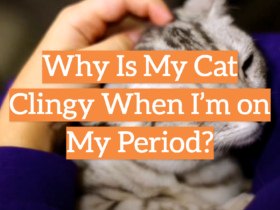



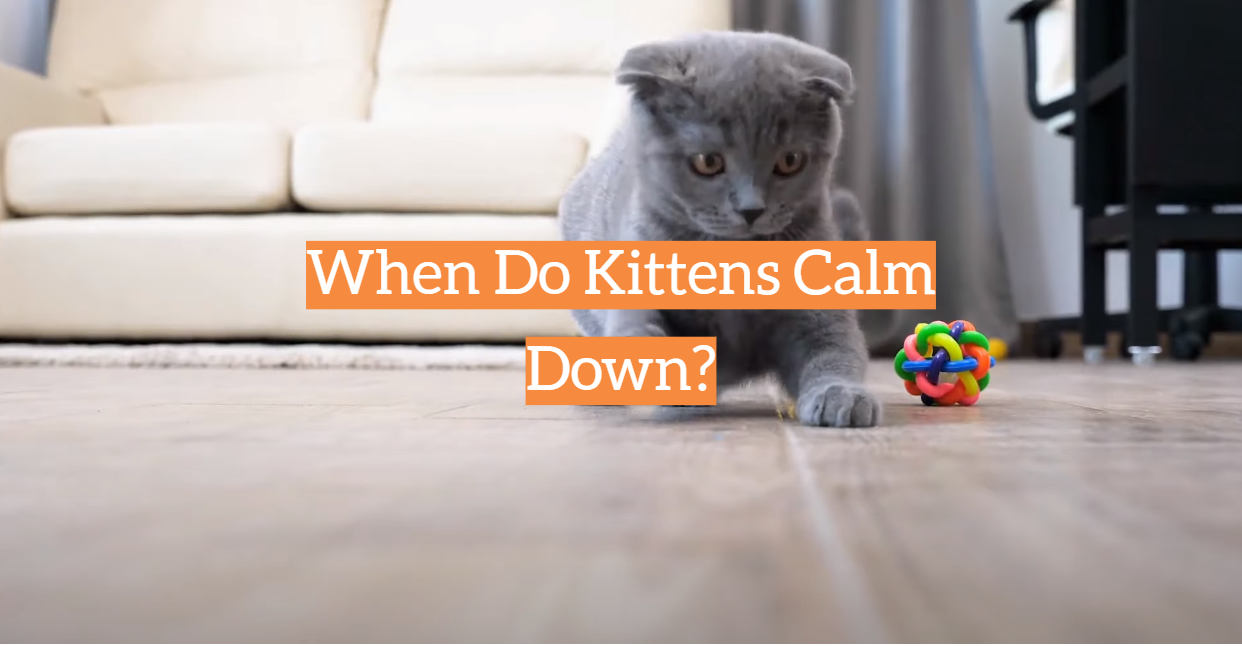
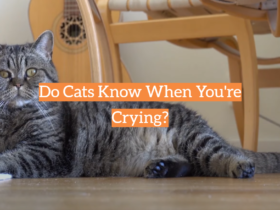
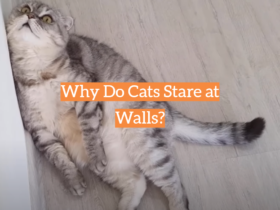

Leave a Reply